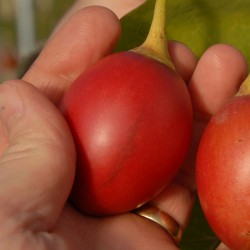Special Offers
Redeem Offer Code
Redeem Gift Voucher
Scarecrow Members
Our Feedback
Team at Victoriana,
Thank you for the recent delivery of trees, bushes and plants. All excellent quality as your regular customers know they can expect. First class packing and packing material, straw, whiich I can use in the garden.
Many thanks, Best wishes,
Betty Dawes, Matlock, Derbyshire
Tamarillo Tree Tomato Plant






Solanum betaceum
- Also known as New Zealand Tree Tomato Plant.
- Produces ruby red egg shaped fruits in late autumn and winter.
- Very versatile.
- Perennial in habit.
- Requires winter frost protection.
Do not plant out (without protection) until fear of frost has passed.
Supplied as pot grown plants approximately 4" (10 cm) tall.
This Product is Available Now.1 or more £7.95GBP each. Group & quantity discounts
Description
Fruiting late autumn to early winter, the egg-shaped ruby red fruits have more of sweet flavour as opposed to the traditional 'savoury' flavour of a tomato. The fruit can be eaten raw, stewed, grilled, bottled, chopped in salads, to garnish steaks, liquidised to make fruit drinks or sorbet, made into pickles, wines, or delicious jams and fruit jelly - it really is a lovely to grow and eat!
Whilst these originated from South America it is in New Zealand where this has become a really popular crop.
- Perennial in habit, the plant itself grows at a staggering rate and looks not unlike a rubber tree in appearance.
- Potentially this can grow to around 12 feet (3.65 metres) tall with a spread up to 8 feet (2.4 metres) - but can be kept with pruning to a height of around 6 feet (1.8 metres).
- In Summer grow it in a large tub; it can be grown outdoors but remember, move inside before the onset of snow and frost!
- Pot on as required, gradually increasing in pot size using either a John Innes No.2 or similar peat based compost.
- Ideally you should end up in a large container - half barrel or similar. Whatever you use, ensure it is well drained to avoid water-logging.
- It is quite natural for the lower leaves to yellow and drop off as it grows to maturity and need not cause any concern.
- Only moderate feeding with a sensible product, such as our Instant Life is recommended. On no account use bonemeal, fresh manure or any other additive to encourage lank 'soft' growth.
- The ideal Winter growing temperature for these is around 60F (15C) or above, however these survive at temperatures as low as 40F (5C). Whilst we have known these to recover even after frost, but intense cold and damp is not recommended.
- Like all garden stock, care should be exercised to control the usual run of pests and diseases, i.e. white fly, aphids and soil pests. Any spray used on tomatoes or fuchsias will not prove harmful to the Tamarillo.
- Should your Tamarillo grow too big in a short space of time, it can be headed back with a saw. This sounds very drastic but recovery is quite staggering with many fresh shoots breaking from the stem. Only permit about three.
- White clusters of flowers appear, similar to potato flowers. These self pollinate and egg shaped fruits subsequently develop.
- An individual tree can produce several hundred fruits in varying stages of ripening spreading cropping over several months. It is ripe when the fruit darkens to a deeper red and often will drop.
How To...
How To Grow Exotic Fruits
Basic guidance on how to plant and growing exotic fruits including Loquats, Citrus, Pineapple Guavas, Olives, Pomegranates and Passion Fruits.

 01233 740529
01233 740529


